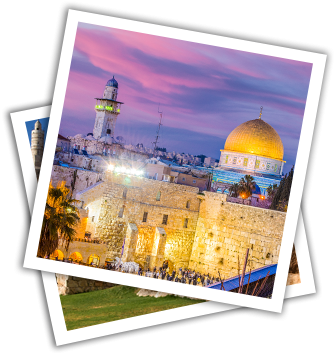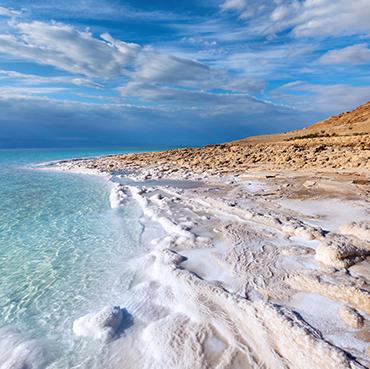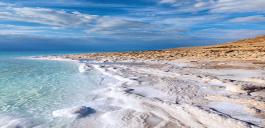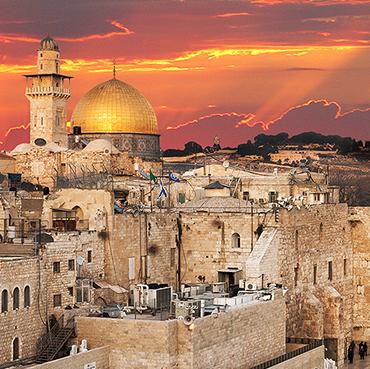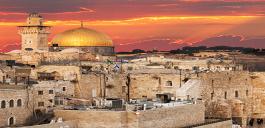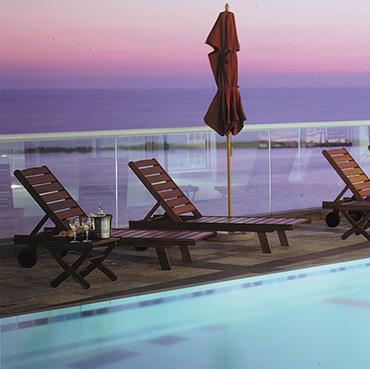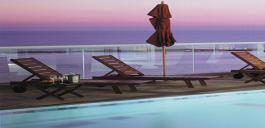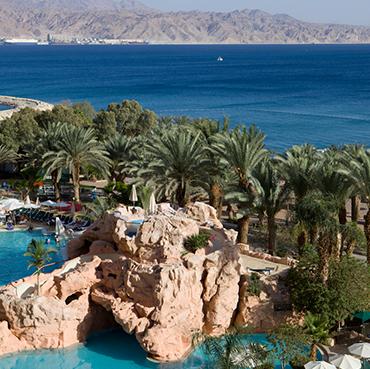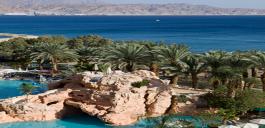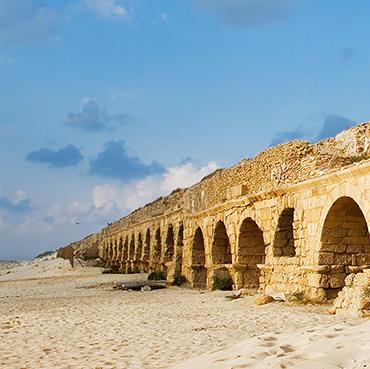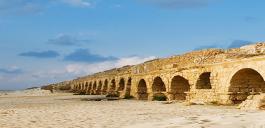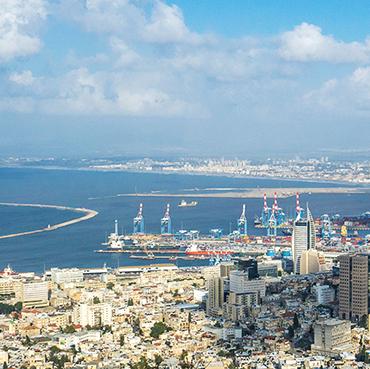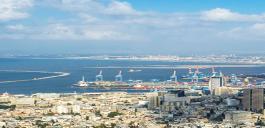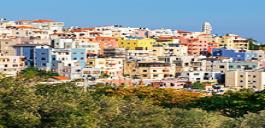Dan Hotels offer a choice of four hotels in Jerusalem, each with its own unique charm and luxury. The iconic flagship of the group, the King David Jerusalem Hotel, boasts a rich history and 5-star super deluxe accommodation. With its 237 rooms, it's a testament to grandeur and comfort. The breath-taking and idyllic Dan Jerusalem Hotel, the outstanding Dan Panorama Jerusalem Hotel ideally located near the Old City, and the urbane and stylish Dan Boutique Jerusalem Hotel complete the list.
Where to Stay in Jerusalem?
When you stay at Dan’s luxurious hotels, you are never far from Jerusalem’s major tourist attractions and historical sites. Our hotels in Jerusalem are ideally located near the Old City of Jerusalem, at the city center or outside the Old City. This makes them perfect choices for those looking for hotels in Jerusalem near the Western Wall. For those seeking kosher hotels in Jerusalem, all Dan Hotels are an excellent choice.
Whether you're embarking on a spiritual journey, exploring the rich history, or simply soaking in the vibrant culture, our hotels provide the perfect base for your adventures in Jerusalem. Each hotel offers excellent amenities and world-class service, ensuring a comfortable and memorable stay.
Exploring Jerusalem
Jerusalem is sacred to the three major Abrahamic religions. It is the ancient capital of Israel, it is the birthplace of Christianity, and is a holy city for Muslims. Since the early 19th century, the Old City has been divided into four quarters: the Jewish Quarter, the Christian Quarter, the Muslim Quarter and the Armenian Quarter. The Old City is a UNESCO World Heritage site, and home to many places with deep religious significance, including the Western Wall, the Church of the Holy Sepulchre, the Dome of the Rock and Al-Aqsa Mosque.
Modern Jerusalem extends far beyond the walls of the Old City. The famous Mahane Yehuda food market encapsulates the city’s ethnic and culinary diversity, while the beautiful Mamilla pedestrian mall near the Jaffa Gate is home to designer stores and luxury shopping. Don’t miss the stunning Israel Museum with its archaeological exhibits, historic artifacts, paintings of the great masters, an extensive modern-art collection and much more. Here is where you will find the Dead Sea Scrolls in the Shrine of the Book, a white-domed structure specially designed to display the delicate manuscripts.
Walking around the Old City of Jerusalem can take a few hours, depending on how many sites you choose to visit. However, the experience is worth every minute spent.
Jerusalem Weather
With its crisp and cool evenings, even during Israel's long summers, Jerusalem’s climate offers an extra measure of welcome to anyone wishing to escape the humidity of the Mediterranean coast or the heat of the dry desert to the east. The description of Jerusalem as “The City of Gold” is due to the distinctive honey-colored Jerusalem stone that shimmers with extraordinary intensity at sunset.
The hottest month is usually July, with average high temperatures reaching around 30°C (86°F). On the other hand, the coldest month is typically January, where temperatures can drop to an average low of 6°C (43°F). Despite these extremes, Jerusalem's weather is generally mild and pleasant, making it a great destination year-round.
Experience Jerusalem with Dan Hotels
Book now and enjoy the best rate for the best of Dan's Jerusalem hotels. Each hotel has its own unique charm and amenities, and they are all conveniently located near several of Jerusalem's major attractions. This makes them the perfect base for your exploration of the city's rich history and vibrant culture.
From the ancient walls of the Old City to the bustling Mahane Yehuda Market, from the sacred Western Wall to the stunning Israel Museum, our hotels put you at the heart of it all.
Your stay in Jerusalem - Frequently Asked Questions
What part of Jerusalem is best to stay in?
Staying in the right part of Jerusalem can transform your trip. The neighborhoods of the German Colony and Rehavia are top picks—quiet, elegant, and full of charm, with leafy boulevards, cozy cafés, and a relaxed local vibe. You’ll be within easy reach of iconic sites like the Old City, Mamilla Mall, and the buzzing First Station complex, all just a short walk or quick ride away. It’s a perfect balance: close to the action but tucked away from the noise.
What is the most visited place in Jerusalem?
The Western Wall (Kotel) is an ancient, deeply spiritual site drawing millions each year. It’s the last remaining wall of the Second Temple and a profound place of prayer and reflection for Jews. It’s also open to all faiths and free to visit 24/7, with a special atmosphere during Shabbat or Jewish holidays. Just steps away are the Dome of the Rock and Al-Aqsa Mosque, both central to Islamic tradition, making the Old City a spiritual crossroads and a magnet for pilgrims. The underground Western Wall Tunnels tour is recommended: a hidden gem giving you a deeper look beneath the surface, literally.
How many days do you need in Jerusalem?
You need at least 3 full days to get a real feel for Jerusalem. One day to explore the Old City—from the Western Wall to the Church of the Holy Sepulchre to the Arab souks or markets. Another to dive into the modern side: Yad Vashem (Holocaust Museum), the Israel Museum (home to the Dead Sea Scrolls), and maybe the Mahane Yehuda Market for food and local flavor. And a third day gives you time for a slower wander—perhaps a guided walk through lesser-known quarters, a trip up the Mount of Olives, or even a food tour. If you can, give yourself time to absorb it all.
Is Jerusalem a walkable city?
Yes and no. The Old City is super walkable, but it’s also a maze of ancient alleyways, uneven stones, and lots of steps—so wear good shoes and be ready to take your time. Outside the Old City, West Jerusalem (downtown, Mahane Yehuda, Rehavia) is easy to explore on foot, with sidewalks, cafes, and parks all fairly close together. But the city is built on hills, and distances between neighborhoods can be deceptive. Overall: walkable in parts, but don’t underestimate the terrain.
What is the best time of year to visit Jerusalem?
Spring (April–June) and autumn (September–November) are the perfect times to visit Jerusalem—pleasant weather, fewer tourists, and vibrant city life. The markets bloom with color, and the golden streets glow. Major holidays like Passover and Easter add rich cultural energy. December brings cooler days, but Christmas in the Old City and Bethlehem offers a magical, unforgettable experience.
How long does it take to walk around the Old City of Jerusalem?
A basic walk around Jerusalem’s Old City walls takes 1–2 hours, but exploring inside is far more rewarding. Visiting all four quarters—Jewish, Christian, Muslim, and Armenian—plus the markets, holy sites, and hidden courtyards can take 4–6 hours. Add another hour or two for the scenic Ramparts Walk. The area is compact but full of surprises—narrow alleys, staircases, and rich history. It’s less about rushing through landmarks and more about discovering wonder around every corner.
What to do indoors in Jerusalem?
Jerusalem offers plenty to do indoors, especially in bad weather. Visit the Israel Museum for ancient artifacts and modern art, or Yad Vashem for a powerful Holocaust memorial. For something different, try the Museum of Islamic Art or Bible Lands Museum. Mahane Yehuda Market, partly covered, is great for food, with cooking workshops too. Religious landmarks like the Church of the Holy Sepulchre and Hurva Synagogue are awe-inspiring. Cozy cafes and boutique cinemas, like the arthouse Lev Smadar, add warmth during cooler months.
Can I visit the Old City of Jerusalem?
Yes, and you absolutely should. The Old City is open to all and holds deep significance for Judaism, Christianity, and Islam. Explore its four quarters and iconic sites like the Western Wall, Church of the Holy Sepulchre, and, when accessible, the Dome of the Rock and Al-Aqsa Mosque. Entry is free, but modest dress is expected. Some sites close or have limited hours on Fridays, Saturdays, and holidays, so plan ahead. A guide—or a solid app—can really enhance the experience. It’s one of the most complex and captivating square kilometers on Earth.
What is the area of Jerusalem’s Old City?
The Old City of Jerusalem covers just under 1 square kilometer (about 0.4 square miles), meaning you could fit around four of them in Central Park, New York. But don’t let its small size fool you—it’s dense with thousands of years of history. The area has multiple gates (some open, some not), and divided into four distinct quarters: Jewish, Christian, Muslim, and Armenian. Within those boundaries are some of the world’s most sacred religious landmarks, dozens of churches, mosques, synagogues, schools, and markets.
What is the difference between the Old City and City of David?
The Old City and the City of David are two ancient but distinct areas in Jerusalem. The Old City is the walled section most visitors explore, home to the Western Wall, Church of the Holy Sepulchre, and Dome of the Rock. Just outside its southern wall is the City of David, the original site of ancient Jerusalem from over 3,000 years ago. It’s now an archaeological park where you can walk through ancient tunnels and see where King David is to have ruled.



